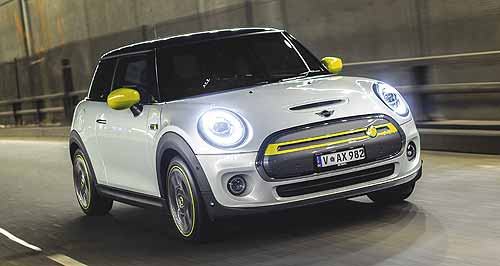News - Market Insight - Market Insight 2020Market Insight: Electrified vehicle sales rocketGrowing appetite: New offerings like the Subaru Forester hybrid (left) and Mini Cooper Electric (below) have contributed to an increase in electrified vehicle sales. Buyers turn to EVs, hybrids as the petrol/diesel car and SUV markets wallow19 Oct 2020 By NEIL DOWLING THE spark has come back into the new passenger vehicle market with electrified cars and SUVs showing they are bucking the downward trend of diesel and petrol vehicles.
The conventionally fuelled passenger car and SUV sector is down 49.9 per cent year-to-date in 2020 compared with 2019 but the EV, hybrid and PHEV (plug-in hybrid) sector is up 18.8 per cent for the same period.
Part of the reason is the groundswell of support for the perceived environmental benefits of a full electric, hybrid and PHEV vehicle, which has consequently been aided by the number of models proliferating in the Australian market.
Based on trends in other markets, activation in the electric-vehicle sector is stimulated by a large choice of vehicles, government incentives and in the case of pure EVs, access to public charging stations.
Australia has been accused of dragging its feet however this year is marking a turning point, triggered by a growing model range.
Toyota has eight hybrids available and more to come (though the Prius C is on its way out) with the latest being the Yaris and C-HR. Sister company Lexus has eight models available with a hybrid powerplant.
The Toyota RAV4 hybrid reflects the opportunities in the market when the three stars – SUV, Toyota and fuel-efficient hybrid – align.
When launched, demand outstripped supply and buyers waited up to six months while many opted out of the wait and drove away in a petrol RAV4.
Sales year-to-date for the RAV4 – which is Toyota’s top-selling vehicle (when splitting HiLux between 4x2 and 4x4) and was the nation’s best selling car in July – are 27,111, with the majority being hybrids to really kick up the electrified vehicle market.
Hybrid engines are now found in more than 10 Mercedes-Benz models as PHEV and hybrid-assist vehicles along with the full-electric EQC400 SUV.
Volvo has three PHEV models, Jaguar Land Rover has one EV (I-Pace) and PHEV Range Rover, and Porsche has two PHEVs along with its EV Taycan.
Hyundai has its Kona EV and Ioniq range of hatchbacks with a choice of hybrid, PHEV or EV; Nissan has its Leaf EV but still lists its Pathfinder hybrid; Subaru introduced a hybrid version of its Forester and XV earlier this year; and Mitsubishi continues to do well with its Outlander PHEV.
Mini is new to the EV game with a Cooper Electric; Honda has its NSX sportscar and a hybrid Accord (after pulling hybrid small cars including the City); there is a PHEV version of Ford’s new Escape SUV; and Tesla has its Model 3, Model X and Model S.
Audi and BMW are expanding their ranges, with Audi’s E-Tron brand in wagon and Sportback; while BMW has hybridised versions of models including the 745e while retiring the full-EV i3 and hybrid i8.
For most manufacturers listed here, this is the beginning. Some have yet to show electrified vehicles, including Volkswagen that is holding back in Australia for the ID range of full electric cars and SUVs.
Full-electric vehicles planned for launch in the next six months include the MG ZS EV – touted as becoming the country’s cheapest EV at about $47,000; the Volvo XC40 Recharge; then the Volvo performance offshoot, the Polestar 2.
Kia has scrapped plans for introducing the e-Niro – and potentially the e-Soul – as demand for the EV is too strong in other markets where government incentives and infrastructure favour EVs.
It will, instead, look at hybrid and PHEV versions of the Sorento SUV and a similar power choice for a new crossover planned for launch in 2021.
While the trend in Australia towards electrified vehicles is encouraging, it is still a case of baby steps – the majority of sales in low-emission vehicles come from self-charging hybrids, with 40,834 of the total 43,073 year-to-date electrified sales coming from self-charging hybrids.
Interestingly, Australian year-to-date hybrid sales have doubled exactly over the same period last year, where 20,416 units were sold.
PHEV sales have only risen slightly by 4.4 per cent to 1114 units, while pure EVs have seen a 15.6 per cent climb to 1225 units, however it is worth noting that Tesla sales are not recorded under VFacts, suggesting the number of EV sales in Australia are higher.  Read more31st of August 2020  Market Insight: Toyota’s ‘20:20’ successIndustry moving ‘in right direction’ as Toyota hits own share, hybrid sales targets25th of August 2020  Market Insight: Poor EV report card for AustraliaEV Council report details federal and state policies on EVs, painting dim picture |
Click to shareMarket Insight articlesResearch Market Insight Motor industry news |


















Facebook Twitter Instagram